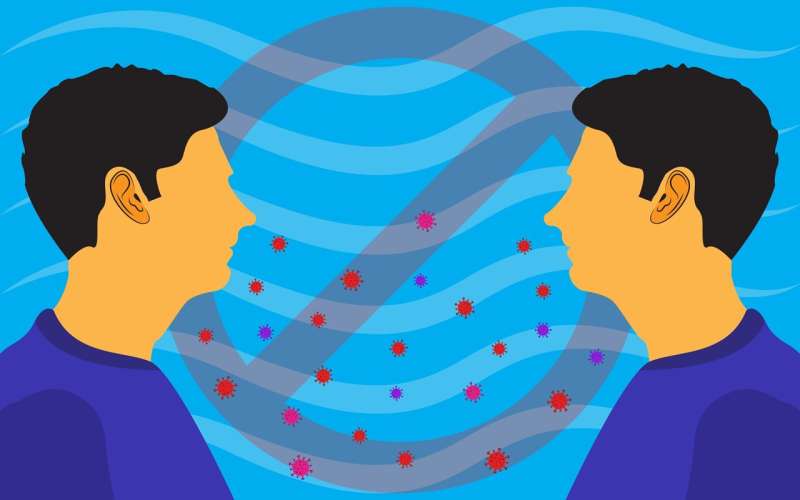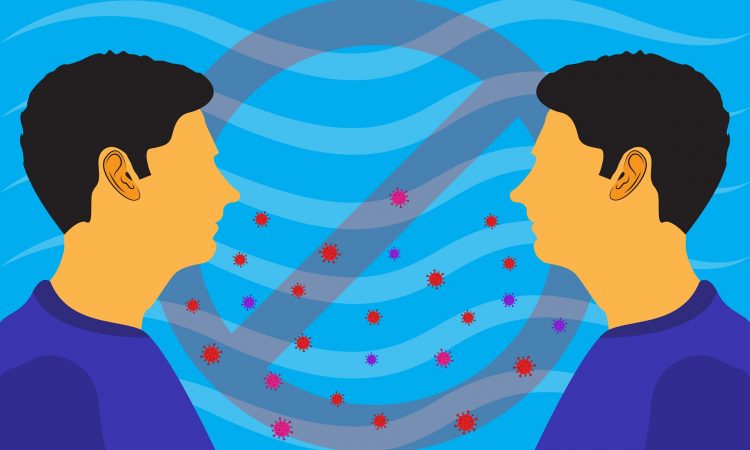
Scientists measuring the frequency and duration of face-to-face interactions between household members have found that close contact had no impact on the transmission of SARS-CoV-2, the virus that causes COVID-19.
The findings, published July 18 in eLife, suggest that airborne transmission may play a larger role in spreading infection in the household and highlights the importance of other preventive factors such as ventilation.
SARS-CoV-2 is spread mainly through droplet-mediated and airborne transmission, and households are a focal point for transmission of the virus.
“Mobility and contact data have shown that the use of non-pharmaceutical interventions such as face masks and social distancing led to a reduction in community contacts and in the opportunity for infection,” says lead author Jackie Kleynhans, Epidemiologist at the National Institute for Communicable Diseases (NICD), a division of the National Health Laboratory Service (NHLS) in Johannesburg, South Africa. “However, the role of contact patterns in the household in the transmission of SARS-CoV-2 is still unknown.”
To obtain data on contact patterns within the household, Kleynhans and the team used devices that broadcast and receive radio frequency waves to measure the frequency and duration of close-proximity, face-to-face contact. Such approaches have been used previously to collect contact data within schools, workplaces and hospitals—and specifically for SARS-CoV-2 to investigate the effectiveness of non-pharmaceutical interventions on cruise ships.
The researchers enrolled 88 adults aged 18 years who had a positive PCR test for SARS-CoV-2 alongside their 252 household contacts. All participants wore the proximity sensors and provided regular nasal swabs and details on symptoms and health care seeking over a period of two weeks. The team also recorded factors such as household size and the number of rooms used for sleeping, alongside personal characteristics such as underlying illness, demographics, education and whether the person with COVID-19 was sleeping in a room with another household member.
Most of the household participants lived in a house with three to five members. Nearly half (49%) lived in a home with only one to two rooms used for sleeping, and a third lived in crowded houses with more than two people per sleeping room.
On average, household members were in close proximity with each other for a maximum of 18 minutes each day (although some were in close proximity for up to 45 minutes), and the average number of times household members were in close proximity each day was 26 (ranging from 10–58) for an average duration of 0.7 minutes. Children younger than 12 years and adults between 35 and 59 years had the highest duration of daily contact, and children aged 5–17 years had the highest average duration and frequency of close contact.
When the data was controlled for the participants’ age and virus variant, it suggested that female contacts were more than twice as likely to contract the virus, and people with a higher viral load were 10 times more likely to be infected. However, the authors were surprised to find that there was no association between the frequency or duration of close contact between household members and the likelihood of contracting COVID-19.
They speculate that this may suggest the virus is predominantly transmitted in the air, especially in poorly ventilated and crowded households, rather than in droplets that might be transferred when in close face-to-face contact. “It was also interesting that teenagers and adults were at the highest infection risk, but children aged 5–17 had the highest contact frequency,” Kleynhans says.
The authors acknowledge a number of limitations of their study. For example, due to the nature of its design, they would have missed the period when the first case of COVID-19 among the participants was most infectious, just before the onset of symptoms. The close‐range contact patterns measured during the study may have been different after the household members were aware of the first case—leading to reduced contact—and again once secondary cases were informed of their infection status, leading to increased contact.
“While recognizing the limitations, our work does not suggest an association between close-proximity contacts and SARS-CoV-2 transmission in South African households. Nevertheless, we’ve provided high-resolution contact data that can be used in future transmission models for SARS-CoV-2 and other pathogens,” concludes senior author Stefano Tempia, Senior Epidemiologist at the NICD and Associate Professor at the University of the Witwatersrand, Johannesburg, South Africa.
“If aerosol transmission plays a more important role than droplet-mediated transmission, then ventilation within households should be considered in future studies. Our findings also emphasize the important role that increased ventilation may play in reducing secondary transmission of SARS-CoV-2 in households,” said Tempia.
More information:
Jackie Kleynhans et al, Association of close-range contact patterns with SARS-CoV-2: a household transmission study, eLife (2023). DOI: 10.7554/eLife.84753
Journal information:
eLife
Source: Read Full Article
